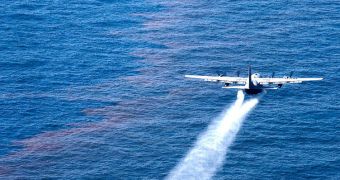One of the most defining traits of any oil spill is the fact that it's black. The tar and crude cover the surface of land or water in a thin, black layer, which causes a lot of damage, and also gives the slick its characteristic look. But this does not appear to be the case with the most recent disaster of this nature. The oil spill taking place in the Gulf of Mexico for the last month has covered the waters of the Atlantic Ocean with a reddish slick, which has left scientists puzzled. They infer that the mixing process currently taking place between water and oil must have something to do with this peculiar event, but a connection is not immediately visible, LiveScience reports.
“We believe that the reddish brown color is indicative of the formation of a water-in-oil emulsion, called a mousse. These [oil slicks] typically have colors other than black, but with this oil, the colors are fairly vivid. We still don't know the exact cause of the color change but it probably as something to do with the water/asphaltene interactions,” explains Louisiana State University professor emeritus Edward Overton, who is a member of the team conducting investigations into this issue. He adds that asphaltene compounds are essentially remnants of the green plant pigment called chlorophyll, and that the chemicals make up an important part of the crude oil.
Since April 20, when the Deepwater Horizon semi-submersible drilling rig exploded, killing 11, thousands of barrels of crude oil have been leaking into the waters of the Gulf of Mexico. The oil slick has extended considerably in the month that passed, and now threatens delicate coastal areas. Some say underwater plumes may have entered the Loop Current, which is a deep-water current that heads east, towards Florida, and then even further, into the Gulf Stream. Since April 22, when the rig sunk, British Petroleum, the company in charge of operating the platform, has been struggling to contain the situation with federal help, but thus far efforts have been in vain.
US Interior Secretary Ken Salazar, in what was qualified as the harshest attack on BP since the crisis began, said that the federal government might push BP out of the way, and assume command of the clean-up efforts in the Gulf of Mexico. The official blasted BP for missing “deadline after deadline” in its efforts to seal the oil leaks. Currently, more than 5,000 barrels of crude are spewing into the Gulf every day, but these are only estimative numbers. The actual figure may be several times as high, given that researchers have still not identified the underwater plumes that were formed. These formations could be anywhere, and detecting them is very difficult without proper scientific studies of areas adjacent to the initial site of the accident.

 14 DAY TRIAL //
14 DAY TRIAL //